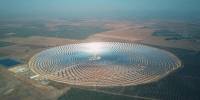A solar combisystem provides solar space heating and cooling as well as hot water from a common array of solar thermal collectors, which is usually supplemented by a non-solar heat source. It is a type of renewable energy system that integrates solar thermal technology with other heating and energy systems in a building. It is also known as a solar combination system or solar thermal combisystem. It is intended to provide space heating as well as domestic hot water by utilizing solar energy as the primary heat source.
Solar combisystems can range in size from those installed in single homes to those serving multiple properties in a block heating scheme. District heating schemes that serve larger groups of properties are commonly referred to as central solar heating schemes.
Many different types of solar combisystems are manufactured; over 20 were identified in the first international survey, which was conducted in 1997 as part of IEA SHC Task 14. However, because different systems have evolved in different countries, the systems on the market in a specific country may be more restricted. Prior to the 1990s such systems tended to be custom-built for each property. Since then commercialised packages have developed and are now generally used.
The basic components of a solar combisystem typically include:
- Solar Collectors: These are typically flat-plate or evacuated tube collectors that capture the sun’s energy and convert it into heat. The collectors are usually mounted on the roof or a south-facing wall to maximize solar exposure.
- Heat Transfer Fluid: A heat transfer fluid, such as water or a mixture of water and antifreeze, is circulated through the solar collectors to absorb the heat energy from the sun.
- Storage Tank: The hot water produced by the solar collectors is stored in a storage tank. It acts as a thermal buffer, ensuring a steady supply of hot water even when solar radiation is low.
- Backup Heating System: When solar energy is insufficient to meet heating needs, a backup heating system, such as a gas or electric boiler, can be integrated into the combisystem. This ensures that the building has a consistent source of heat.
- Distribution System: A distribution system, which consists of pipes, pumps, and controls, is used to circulate hot water from the storage tank to the building’s various heating and hot water outlets.
The solar combisystem works by using solar energy to warm the water before it enters the backup heating system. Solar collectors directly heat the water during periods of sufficient solar radiation. If solar energy is insufficient, the backup heating system kicks in to provide the required heat.
The benefits of a solar hybrid system include less reliance on fossil fuels, lower energy costs, and lower greenhouse gas emissions. It can contribute to a more sustainable and environmentally friendly heating and hot water solution for residential and commercial buildings by harnessing the sun’s energy.
















